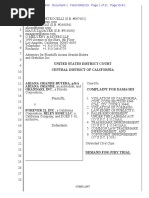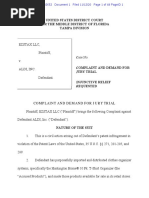Law436 Contracts Final Assessment
Law436 Contracts Final Assessment
Uploaded by
aurymCopyright:
Available Formats
Law436 Contracts Final Assessment
Law436 Contracts Final Assessment
Uploaded by
aurymOriginal Description:
Copyright
Available Formats
Share this document
Did you find this document useful?
Is this content inappropriate?
Copyright:
Available Formats
Law436 Contracts Final Assessment
Law436 Contracts Final Assessment
Uploaded by
aurymCopyright:
Available Formats
LAW OF CONTRACTS 1 (LAW436)
FINAL ASSESSMENT ANSWER
Name: Muhammad Amar Fitri Bin Mohd Khalid
Matrix No.: 2020989263
Class: LWB01E
QUESTION ONE
Suhaila is the youngest daughter of Dato Sulaiman, she recently obtained her
degree in Early Childhood Education. With encouragement from her parents,
Suhaila decided to operate her own kindergarden.
She began by searching for an appropriate premise. She found a new corner
terrace house with a large compound. The advertisement at the house stated that
the selling price was RM650,000.00 (negotiable). Interested buyers may contact the
owner, Eric Chew. After viewing the house, Suhaila offered Eric Chew
RM600,000.00 for the house. The owner, Eric Chew, however firmly stated that he
cannot accept RM600,000.00. Instead he will consider, and he offered Suhaila
RM625,000.00.
Suhaila was sceptical about the offer and continued to view another property. She
subsequently found a suitable house and purchased it.
Meanwhile, Suhaila decided to advertise in the local newspaper for the position of an
assistant and a cook for her new kindergarden. Suddenly Suhaila was afraid if she
will receive too many applications and wants to confirm if she is obliged to accept the
first application received.
Eric Chew has been calling Suhaila, demanding that she proceed with the purchase
of his house.
With reference to relevant authorities, advise Suhaila on the following:-
i) Whether Suhaila is obliged to proceed with the purchase of Eric Chew’s
house?
(20marks)
ISSUE
The issue is whether Suhaila is obliged to proceed with the purchase of Eric
Chew’s house.
LAW
Section 2(h) of the Contract Act 1950 provides that an agreement enforceable
by law is a contract. Furthermore, Section 10(1) of the Contract Act 1950 states that
all agreements are contracts if they are made by the free consent of parties
competent to contract, for a lawful consideration and with a lawful object, and are not
hereby expressly declared to be void. There are 8 elements that must be fulfilled to
form a valid contract. They are, offer, acceptance, consideration, intention to create
legal relations, certainty, formalities, legal capacity, and free consent.
Section 2(b) of the Contract Act 1950 talks about the definition of acceptance.
It states when the person to whom the proposal is made signifies his assent thereto,
the proposal is said to be accepted: a proposal, when accepted, becomes a promise.
Before there can be acceptance in law, there must be the fact of acceptance as well
as communication of acceptance. In order to convert a proposal into a promise the
acceptance must be absolute and unqualified and also be expressed in some usual
& reasonable manner. An acceptance is a final and unqualified expression of assent
to the terms of the offer. However, if the reply is qualified or attempts to vary the
terms or attempts to accept the offer on new terms, there is no communication of
acceptance but only a rejection accompanied by a counteroffer. This can be seen in
the case of Hyde v Wrench. In said case, the defendant offered to sell his estate to
the plaintiff on June 6 for 1000 pounds. On June 8 in reply, the plaintiff made a
counter proposal to purchase the estate at 950 pounds. On June 27, the defendant
refused to accept this offer. Two days later, the plaintiff wrote to the defendant that
he was prepared to pay 1000 pounds. The defendant refused and the plaintiff sued
for specific performance. The court held that there was no acceptance because the
plaintiff’s letter on 8 June had rejected the original proposal, which could not be
revived.
There are three situations where the acceptance is not absolute and
unqualified. The first one is counter offers by the offeree. The second one is the
terms of the offer were amended at the time of acceptance. The third is when
acceptance made is subject to contract. Acceptance must also correspond to the
offer. This includes cross offer, knowledge of offer before acceptance and the motive
of acceptor at the time of acceptance.
The acceptance must be communicated clearly between the two parties.
Silence is not considered an acceptance. This can be seen in the case of Felthouse
v Bindley. In that case, the plaintiff wrote to his nephew offering to buy the nephew’s
horse and adding that “if I hear no more about him, I consider the horse mine at 30l.
15s.” The nephew did not reply, and no money was paid. The horse remained the
nephew’s possession. Six weeks later, the defendant, an auctioneer who was
employed by the nephew to sell his farming stock, was directed by the nephew to
reserve the horse in question. As it had already been sold. But by mistake had put it
up with the rest of the stock and sold it. The plaintiff sued for conversion of the horse.
The court held that there was no contract between the plaintiff and his nephew. This
is because there was never any clear acceptance and silence on one side does not
equate to acceptance.
An Invitation to treat is not an offer, but a sort of preliminary communication
which passes between the parties at the stage of negotiation for example, display of
goods in a shop window, advertisements or also an auction. This can be seen in the
case of Fisher v Bell where the defendant had displayed in his shop window a flick
knife which was a ticket bearing the “Ejector Knife-4s”. he was charged with offering
for sale a flick knife contrary to the regulations. The court held that the displaying of
the flick knife was merely an invitation to treat hence there was no offer for sale and
the defendant could not be guilty of an offence.
APPLICATION
In this present case, Suhaila was searching for a house and came across one
being sold by Eric for the price of RM650,000. This price is said to be negotiable by
Eric and any interested buyers can contact him. This is an invitation to treat by Eric
to attract buyers. As such, Suhaila made an offer to buy the house at RM600,000 to
which Eric rejected outright. Eric made a counteroffer to Suhaila to sell the house for
RM625,000. Suhaila was sceptical about this and never responded back to Eric. In
applying the principle in the case of Hyde v Wrench, Eric made a counteroffer which
made the original offer by Suhaila no longer acceptable. It is up to Suhaila whether
or not she wants to accept the counteroffer by Eric. Suhaila kept silent about the
matter and moved on to view other properties. Suhaila’s silence is not an acceptance
as evidenced in Felthouse v Bindley. Therefore, Suhaila never accepted Eric’s
counteroffer to purchase the house for RM625,000 and there is no contract between
them since there was no acceptance.
CONCLUSION
In conclusion, Suhaila is not obliged to proceed with the purchase of Eric
Chew’s house. This is because she never accepted Eric’s counteroffer in the first
place.
ii) Whether Suhaila is obliged to accept the first application she receives.
(20marks)
ISSUE
The issue is whether Suhaila is obliged to accept the first application she
receives.
LAW
Section 2(a) of the Contract Act 1950 states that a proposal is made when
one person signifies to another his willingness to do or abstain from doing anything,
with a view of obtaining the assent of that other to such act or abstinence. This
means that the willingness of someone means an offer. Section 2(h) of the Contract
Act 1950 provides that an agreement enforceable by law is a contract. Furthermore,
Section 10(1) of the Contract Act 1950 states that all agreements are contracts if
they are made by the free consent of parties competent to contract, for a lawful
consideration and with a lawful object, and are not hereby expressly declared to be
void. There are 8 elements that must be fulfilled to form a valid contract. They are,
offer, acceptance, consideration, intention to create legal relations, certainty,
formalities, legal capacity, and free consent.
An Invitation to treat is not an offer, but a sort of preliminary communication
which passes between the parties at the stage of negotiation for example, display of
goods in a shop window, advertisements or also an auction. This can be seen in the
case of Fisher v Bell where the defendant had displayed in his shop window a flick
knife which was a ticket bearing the “Ejector Knife-4s”. he was charged with offering
for sale a flick knife contrary to the regulations. The court held that the displaying of
the flick knife was merely an invitation to treat hence there was no offer for sale and
the defendant could not be guilty of an offence. Also, in the case of Harris v
Nickerson, the defendant made an advertisement for a sale of certain goods,
including certain office accessories on a certain date at a particular place. When the
plaintiff knew so he traveled to the location and discovered that the office
accessories had been withdrawn from the sale. So, he brought an action to claim for
damages and argues that the defendant had breached the contract since the
advertisement was an offer and his presence at the sale was an acceptance to the
offer. The court held that the advertisement was an invitation to treat and rejected his
claim.
An offer can be made to a specific person or the general public. If made a
specific person, only that person may accept the proposal. If the offer is made to the
general public, anyone who meets the all the terms of the proposal may accept it.
This can be seen in the case of Carlill v Carbolic Smoke Ball Co. In said case, the
defendants company advertised they would offer 1000 pounds to anyone who still
succumbs to the influenza after using the company’s medicine according to the
instructions for a fixed period. The plaintiff duly used the product, but nevertheless
still contracted the influenza. The plaintiff then sued for money. The Court of Appeal
held that the plaintiff had accepted the offer of the company made the whole world at
large and is therefore entitled to the money. Whether an advertisement is a proposal
or an invitation to treat depends on the intention of the parties in each case.
APPLICATION
In this present case, Suhaila decided to advertise in the local newspaper for
the position of an assistant and a cook for her new kindergarden she wants to open.
Suhaila was afraid if she will receive too many applications and wants to confirm if
she is obliged to accept the first application received. Suhaila can accept the first
application received, she is not however, obliged to accept it. Applying the principle
in the case of Harris v Nickerson, it is because her advertisement was an invitation
to treat. Anyone can come up to Suhaila regarding the job advertisement since it is
open to anyone who is qualified for the role. It is then up to Suhaila to decide among
all the applicants who is the best suited. Suhaila may choose whoever she likes, and
the applicants cannot claim that Suhaila must choose them since they were the first
to apply for example.
CONCLUSION
In conclusion, Suhaila is not obliged to accept the first application she
receives. This is because it is only an invitation to treat and she can choose which
ever applicant she wants regardless of when they applied.
You might also like
- Sales of Goods ActDocument6 pagesSales of Goods ActSerena JamesNo ratings yet
- 5 Topic 3 Contract LawDocument35 pages5 Topic 3 Contract LawNordin Yusof71% (7)
- Act 286 Defamation Act 1957Document18 pagesAct 286 Defamation Act 1957Adam Haida & Co100% (1)
- Lecture 9 Hire Purchase LawDocument31 pagesLecture 9 Hire Purchase LawSyarah Syazwan SaturyNo ratings yet
- Assignment Sales of GoodsDocument6 pagesAssignment Sales of Goodsathirah jamaludinNo ratings yet
- Law and Media Sedition Act 1948Document5 pagesLaw and Media Sedition Act 1948Azarith SofiaNo ratings yet
- Tutorial Case Equitable Assignment & Bare TrustDocument28 pagesTutorial Case Equitable Assignment & Bare TrustFarhan KamarudinNo ratings yet
- Division of Matrimonial Assets Case AnalaysisDocument5 pagesDivision of Matrimonial Assets Case AnalaysisElaineSaw100% (1)
- Wong Eng V Chock Mun ChongDocument2 pagesWong Eng V Chock Mun ChongMuhd DanielNo ratings yet
- Ariana Grande v. Forever 21Document21 pagesAriana Grande v. Forever 21Gizmodo EditNo ratings yet
- Prep Suggested Answer 1Document5 pagesPrep Suggested Answer 1xjfdfjdjdNo ratings yet
- BL Chapter 6Document78 pagesBL Chapter 6Nurul IffahNo ratings yet
- Final Assessment: Faculty of Business Management Diploma in Banking (Ba119) Business Law (Law 299)Document19 pagesFinal Assessment: Faculty of Business Management Diploma in Banking (Ba119) Business Law (Law 299)Khadijah MisfanNo ratings yet
- Coercio N: by DR Suzi Fadhilah IsmailDocument57 pagesCoercio N: by DR Suzi Fadhilah IsmailluluNo ratings yet
- Presumption of Advancement (Ponniah Case)Document2 pagesPresumption of Advancement (Ponniah Case)IZZAH ZAHIN100% (5)
- Tort NotesDocument3 pagesTort NotesShäränyä Subramaniam100% (1)
- W6 IllegalityDocument82 pagesW6 IllegalityNu'man AzhamNo ratings yet
- Topic 1 Preliminary Matters PDFDocument15 pagesTopic 1 Preliminary Matters PDFMichelle LimNo ratings yet
- Law TutorialDocument3 pagesLaw TutorialarifahakimahNo ratings yet
- Hee Cheng V KrishnanDocument11 pagesHee Cheng V KrishnanzaimankbNo ratings yet
- Occupier Liability Part 1Document6 pagesOccupier Liability Part 1jtlong0554100% (1)
- Mohd. Latiff Bin Shah Mohd. & 2 Ors. v. Tengku Abdullah Ibni Sultan Abu Bakar & 8 Ors. & 2 Other CasesDocument25 pagesMohd. Latiff Bin Shah Mohd. & 2 Ors. v. Tengku Abdullah Ibni Sultan Abu Bakar & 8 Ors. & 2 Other CasesWai Chong KhuanNo ratings yet
- Yayasan Melaka V Photran Corp SDN BHD & AnorDocument27 pagesYayasan Melaka V Photran Corp SDN BHD & AnorSeng Wee Toh0% (1)
- SogaDocument75 pagesSogaDylan Chong0% (2)
- Private DefenceDocument20 pagesPrivate DefenceAizat Lukman Bin JohanNo ratings yet
- Q&A PartnershipDocument24 pagesQ&A PartnershipLoveLyzaNo ratings yet
- CASE Stakeholder Au Ba ChiDocument9 pagesCASE Stakeholder Au Ba ChiIqram MeonNo ratings yet
- Pre - Incorporation ContractDocument5 pagesPre - Incorporation ContractSiti Fauziani Muhammad naimNo ratings yet
- Chapter 19 Rescission 6 Dec 2013 Now For LectureDocument31 pagesChapter 19 Rescission 6 Dec 2013 Now For LectureHui Yin ChinNo ratings yet
- Soga Presentation Group 4Document11 pagesSoga Presentation Group 4vivek1119No ratings yet
- Harta Empat SDN BHD V Koperasi Rakyat BHD (1997) 1 MLJ 381 COADocument3 pagesHarta Empat SDN BHD V Koperasi Rakyat BHD (1997) 1 MLJ 381 COAAimi AzemiNo ratings yet
- Topic 6 - Damages May 23Document90 pagesTopic 6 - Damages May 23LIM HAI CHENGNo ratings yet
- DIL 1103 Contract Law - Notes On ITCLRDocument3 pagesDIL 1103 Contract Law - Notes On ITCLRZurulNo ratings yet
- TOPIC 1 - Sale of GoodsDocument49 pagesTOPIC 1 - Sale of GoodsnisaNo ratings yet
- Boonsom Boonyanit V Adorna Properties SDN BHDocument10 pagesBoonsom Boonyanit V Adorna Properties SDN BHRita LakhsmiNo ratings yet
- Contract Ii Case Review (Condition)Document9 pagesContract Ii Case Review (Condition)khairiah tsamNo ratings yet
- Contract II Assignment - Final QuesDocument35 pagesContract II Assignment - Final QuessyahindahNo ratings yet
- CASE - Kang Yoon Mook XavierDocument10 pagesCASE - Kang Yoon Mook XavierIqram MeonNo ratings yet
- Remedies 3Document2 pagesRemedies 3Yuvanesh KumarNo ratings yet
- FATIMAH V MOIDEEN KUTTY - (1969) 1 MLJ 72Document5 pagesFATIMAH V MOIDEEN KUTTY - (1969) 1 MLJ 72polarfireflies100% (1)
- Glup 1043 Legal Skill andDocument26 pagesGlup 1043 Legal Skill andBadrun HishamNo ratings yet
- Legal Developments 2015Document13 pagesLegal Developments 2015hasnansuaimiNo ratings yet
- Law of ContractsDocument4 pagesLaw of ContractsIezzatyshzNo ratings yet
- CLJ 1999 4 448Document59 pagesCLJ 1999 4 448Fatin Hamraa100% (1)
- Golden Approach SDN BHD V Pengarah Tanah DanDocument9 pagesGolden Approach SDN BHD V Pengarah Tanah DanIqram MeonNo ratings yet
- HamzahDocument5 pagesHamzahfarahayn100% (2)
- ONG BAN CHAI & ORS V SEAH SIANG MONG - (1998Document23 pagesONG BAN CHAI & ORS V SEAH SIANG MONG - (1998Praba Karan100% (1)
- Standard Chartered V Yap Sing Yoke Ors.Document10 pagesStandard Chartered V Yap Sing Yoke Ors.Arief FirdausNo ratings yet
- 2004 2 MLJ 306Document11 pages2004 2 MLJ 306KkkNo ratings yet
- 2.0 SLIDES-Burden and Standard of ProofDocument25 pages2.0 SLIDES-Burden and Standard of ProofAbidah Abdul Ghafar0% (1)
- WotherspoonDocument5 pagesWotherspoonPyah Manje100% (1)
- Case Review - Musheila EditedDocument9 pagesCase Review - Musheila EditedmusheilaNo ratings yet
- Tutorial 8 Agency BL1AnsDocument4 pagesTutorial 8 Agency BL1AnsStanley StanleyNo ratings yet
- Bank Bumiputra Malaysia BHD & Anor V Lorrain Osman & Ors (1985) 2 MLJ 236Document10 pagesBank Bumiputra Malaysia BHD & Anor V Lorrain Osman & Ors (1985) 2 MLJ 236sitifatimahabdulwahidNo ratings yet
- Class: Lwb02A Date of Submission: 9 September 2020: Faculty of Law Uitm Shah Alam, SelangorDocument27 pagesClass: Lwb02A Date of Submission: 9 September 2020: Faculty of Law Uitm Shah Alam, SelangorAlif Ashraf100% (1)
- Written SubmissionDocument6 pagesWritten SubmissionCyrill CladeNo ratings yet
- Land Law Ii (Charge) : Order For SaleDocument106 pagesLand Law Ii (Charge) : Order For SaleHidayah RoslizanNo ratings yet
- Section 6 Malaysia Land LawDocument5 pagesSection 6 Malaysia Land LawizzatiNo ratings yet
- Chap 2 - Formation of ContractsDocument91 pagesChap 2 - Formation of Contractsng shiminNo ratings yet
- CL AssignmentDocument8 pagesCL AssignmentThomson SongNo ratings yet
- Hyde v. WrenchDocument6 pagesHyde v. WrenchChristian AdongoNo ratings yet
- Notes of Criminal LawDocument5 pagesNotes of Criminal LawPrashant ShahNo ratings yet
- Aocljea3f 010123Document1 pageAocljea3f 010123todd gallagherNo ratings yet
- RICS IPTI Barbados G Roots U Obi Compulsory Purchase & CompensationDocument20 pagesRICS IPTI Barbados G Roots U Obi Compulsory Purchase & CompensationshawnfrankNo ratings yet
- Law EconomicsDocument2 pagesLaw EconomicsDhwanit RathoreNo ratings yet
- Data Privacy Notice and Consent Form For ApplicantsDocument2 pagesData Privacy Notice and Consent Form For ApplicantsJoaquim Marques da CostaNo ratings yet
- Facts:: Camaya v. Patulandong 423 SCRA 480Document2 pagesFacts:: Camaya v. Patulandong 423 SCRA 480Rabelais MedinaNo ratings yet
- 12PPG Week 8 - Phillipine JudiciaryDocument7 pages12PPG Week 8 - Phillipine JudiciaryHannae pascuaNo ratings yet
- New Form 2550 M Monthly VAT Return P 1 2 1Document3 pagesNew Form 2550 M Monthly VAT Return P 1 2 1The ApprenticeNo ratings yet
- Tan v. Dir. of ForestryDocument2 pagesTan v. Dir. of Forestryvallie21100% (1)
- By B.S. Chauhan, Media Advisor To Comptroller & Auditor GeneralDocument4 pagesBy B.S. Chauhan, Media Advisor To Comptroller & Auditor GeneralakhiljindalNo ratings yet
- The Law On Termination of Filipino SeafarersDocument4 pagesThe Law On Termination of Filipino SeafarersjosemiguelreyesNo ratings yet
- Bernabe Vs BolinasDocument2 pagesBernabe Vs BolinasJuvy DimaanoNo ratings yet
- The International Response To The Establishment of The "TRNC"Document7 pagesThe International Response To The Establishment of The "TRNC"Bill MarNo ratings yet
- Investigate PH Initial Report With Annexes March 20,2021Document198 pagesInvestigate PH Initial Report With Annexes March 20,2021Kalovski ItimNo ratings yet
- John v. Grombach v. Oerlikon Tool and Arms Corporation of America, A Corporation, 276 F.2d 155, 4th Cir. (1960)Document13 pagesJohn v. Grombach v. Oerlikon Tool and Arms Corporation of America, A Corporation, 276 F.2d 155, 4th Cir. (1960)Scribd Government DocsNo ratings yet
- Gajanan Moreshwar v. Moreshwar MadanDocument4 pagesGajanan Moreshwar v. Moreshwar MadanYagnesh Patel100% (1)
- Chapter 04 - Empire in TransitionDocument14 pagesChapter 04 - Empire in Transitiontheluckless777No ratings yet
- 2 Maynilad vs. DENR, G.R. No. 206823, August 6, 2019 PDFDocument71 pages2 Maynilad vs. DENR, G.R. No. 206823, August 6, 2019 PDFLuigi JaroNo ratings yet
- 01 Max Shoop Application To Practice Law DigestDocument2 pages01 Max Shoop Application To Practice Law Digestclovis_contadoNo ratings yet
- Gil Mae N. Huelar - Administrative Law, Chapter 6 Case Digest, de Leon - Page 1 of 9Document9 pagesGil Mae N. Huelar - Administrative Law, Chapter 6 Case Digest, de Leon - Page 1 of 9Jil Mei IVNo ratings yet
- Critical Evaluation of World Trade OrganisationDocument8 pagesCritical Evaluation of World Trade OrganisationAfrasiab HassanNo ratings yet
- 1-2-18 Notice of Withdrawal Attorney SolomonDocument1 page1-2-18 Notice of Withdrawal Attorney SolomonAudra ToopNo ratings yet
- Plasabas V CADocument4 pagesPlasabas V CAPie Boja-CosteNo ratings yet
- Introduction To Indian Constitution: Chapter ThreeDocument6 pagesIntroduction To Indian Constitution: Chapter Threesir0906No ratings yet
- Election Commission of India Powers Func PDFDocument9 pagesElection Commission of India Powers Func PDFNasir Alam100% (1)
- CHANGE of Name and Correction of EntriesDocument16 pagesCHANGE of Name and Correction of EntriesRalph HonoricoNo ratings yet
- EZSTAX v. Aldi - ComplaintDocument80 pagesEZSTAX v. Aldi - ComplaintSarah BursteinNo ratings yet
- Indian Income Tax Return Acknowledgement 2022-23: Assessment YearDocument1 pageIndian Income Tax Return Acknowledgement 2022-23: Assessment Yeartejeswararao ronankiNo ratings yet
- 69 City of Manila Vs Cosmos Bottling CorpDocument12 pages69 City of Manila Vs Cosmos Bottling CorpNunugom SonNo ratings yet

























































































